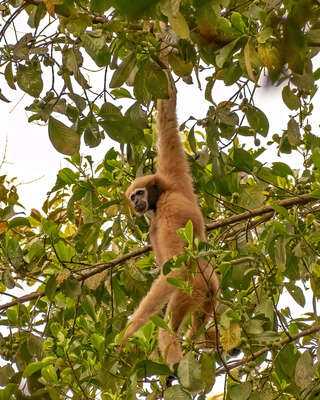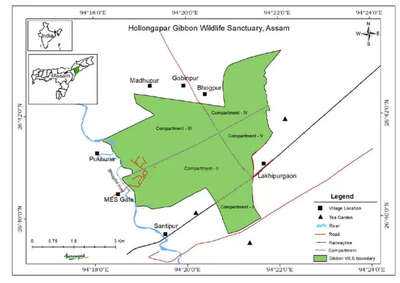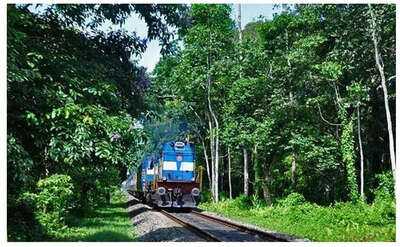As the world marks International Gibbon Day, India’s only ape species, the Western Hoolock gibbon, faces an unprecedented threat to its survival.
Already listed as “endangered” on the IUCN (International Union for Conservation of Nature) Red List, this arboreal primate now contends with an existential risk from a proposed oil exploration project near its last remaining home – the Hollongapar Gibbon Sanctuary in Assam’s Mariani town.
The sanctuary is home to over 120 of these agile apes.
A month ago, the Union Ministry of Environment, Forest, and Climate Change granted in-principle approval to divert 4.50 hectares of forest land within Hollongapar’s eco-sensitive zone for oil and gas exploration by Vedanta Group’s subsidiary, Cairn Oil & Gas.

However, last week, the National Board for Wildlife (NBWL) deferred this decision, recommending a comprehensive site inspection.
Welcoming the deferment, Congress MP from Jorhat Gaurav Gogoi emphasised the need for caution. “The deferment is only a temporary solution. The concerned government agencies must undertake a comprehensive assessment of the situation. Potential short-term benefits cannot come at the expense of Assam’s natural heritage and endangered wildlife,” he wrote on X.
Dr Dilip Chetry, primatologist and head of Assam-based wildlife NGO Aaranyak’s Primates Research and Conservation Division, expressed similar concerns.
“The proposed exploration site is around 13.2 kilometres from the southern boundary of Hollongapar. While it may seem distant, any expansion in this region could significantly affect the sanctuary. A thorough pre-exploration study is crucial to understanding the potential impacts on this delicate ecosystem,” he told this reporter.
The Western Hoolock gibbon is one of the 20 gibbon species in the world, with the 20.98 sq km Hollongapar Gibbon Sanctuary being its last stronghold. The sanctuary is home to seven primate species, the Bengal slow loris, elephants, 219 bird species, over 200 butterfly species, and rare reptiles.
India’s only ape species
Currently there are less than 3,000 gibbons in India, and they are usually seen in the forests of Nagaland, Meghalaya, Manipur, Arunachal Pradesh, Mizoram and Assam. They are known for their distinct 'hook-o, hook-o, hook-o' calls, which can be heard from up to a kilometre away.

At 1.5 feet tall and weighing 6 to 8 kilograms, these primates are built for an arboreal life. Their hallmark brachiation, a special form of arboreal locomotion, enables them to swing up to six metres in a single leap, reaching speeds of over 50 km/h as they move effortlessly between trees.
Males have jet-black coats, while females are a rich brown. Gibbons do not mate within family lines, and once paired, they form lasting monogamous bonds.

As the forest cover diminishes rapidly, the future of these arboreal primates that rely on continuous canopy cover for movement look uncertain. One of the biggest dislocators to the canopy is the 1.65-km broad-gauge railway line of the Northeast Frontier Railway, which cuts the sanctuary into two unequal parts.
The situation is now set to worsen with the Indian Railways' proposed electrification of a 9-km stretch of track, which runs through the sanctuary. This electrification plan, part of India’s larger goal of achieving net-zero emissions by 2030, has sparked alarm among conservationists.
Although electrification is reportedly complete, NBWL has instructed that the wires remain inactive until wildlife crossings are established.
More trouble awaits with the proposed doubling of this track, which would likely destroy canopy bridges that are crucial for gibbon movement.
Chetry, who has played a pivotal role in conceptualising these natural canopy routes and leading ongoing conservation efforts, warns that the current status of the railway project could jeopardise years of progress.
“The doubling of the railway line will lead to canopy clearance, which means that the distance the gibbons have to jump to cross from one side to the other will also increase. Gibbons can jump between 10 to 12 metres, and that won’t be enough to cross the railway track once the canopy is cleared,” he said.

Chetry also highlights that the electrification and doubling of the track could have severe impacts on other species. Elephant herds frequently take this route to migrate between Hollongapar and the Desoi Valley Reserve Forest. Despite the speed limit for trains within the sanctuary being set at 30 km/h, accidents have already resulted in the deaths of several elephants.
“If 11,000 volts of current pass through these lines, several species could lose their lives. Around 70-80 elephants reside near the sanctuary, along with a subadult rhino. Electrification poses significant risks to them, as they could be run over. It is crucial to reroute the railway tracks, to around two kilometres toward the southern boundaries, where tea cultivation land exists. If we don’t act now, this project could cause irreversible damage to Hollongapar’s unique biodiversity,” he warned.
Tea plantations and brick factories pose further threats to this fragile gibbon habitat. Expanding tea estates, including those owned by big companies, have reportedly encroached on the sanctuary's borders, reducing critical forest cover.

The issue is compounded by pesticide runoff from plantations and nearby brick factories, which pollute the air and water. These factories also collect fuel from the sanctuary, further endangering its ecosystem.
Wildlife enthusiast Diganta Kumar Gogoi, who runs the Gibbon Resort in Nagadera village near the sanctuary, emphasises the urgency of the situation.
He said, “The vacant lands around the sanctuary are alarmingly being converted into tea plantation areas. The need of the hour is large-scale tree planting and regeneration to increase forest cover and create more food resources for the various species that depend on it. Once powered, the broad-gauge electrification will anyway lead to immense tree loss.”

Hoolock gibbons hold significant cultural value in Assam and are celebrated in local folklore through rhymes like "Holou uthil tokou gosot logai khodou modou" (the hoolock climbed a palm tree and caused a ruckus). The death of Kalia, a female gibbon in Tinsukia district, led to the declaration of World Hoolock Gibbon Day on January 14, honouring her memory and the species.

Artist Marshall Baruah has harnessed this cultural connection, creating impactful murals to raise awareness during recent protests against the proposed oil exploration project.
“I have always imagined gibbons as an integral part of our rich natural heritage, and the best I could do for the gibbons was to give life to their struggles through my art.”
As the dangers of oil exploration, habitat loss and development pressures mount, urgent action is needed to protect these unique primates and their dwindling habitat.
Already listed as “endangered” on the IUCN (International Union for Conservation of Nature) Red List, this arboreal primate now contends with an existential risk from a proposed oil exploration project near its last remaining home – the Hollongapar Gibbon Sanctuary in Assam’s Mariani town.
The sanctuary is home to over 120 of these agile apes.
A month ago, the Union Ministry of Environment, Forest, and Climate Change granted in-principle approval to divert 4.50 hectares of forest land within Hollongapar’s eco-sensitive zone for oil and gas exploration by Vedanta Group’s subsidiary, Cairn Oil & Gas.

However, last week, the National Board for Wildlife (NBWL) deferred this decision, recommending a comprehensive site inspection.
Welcoming the deferment, Congress MP from Jorhat Gaurav Gogoi emphasised the need for caution. “The deferment is only a temporary solution. The concerned government agencies must undertake a comprehensive assessment of the situation. Potential short-term benefits cannot come at the expense of Assam’s natural heritage and endangered wildlife,” he wrote on X.
Dr Dilip Chetry, primatologist and head of Assam-based wildlife NGO Aaranyak’s Primates Research and Conservation Division, expressed similar concerns.
“The proposed exploration site is around 13.2 kilometres from the southern boundary of Hollongapar. While it may seem distant, any expansion in this region could significantly affect the sanctuary. A thorough pre-exploration study is crucial to understanding the potential impacts on this delicate ecosystem,” he told this reporter.
The Western Hoolock gibbon is one of the 20 gibbon species in the world, with the 20.98 sq km Hollongapar Gibbon Sanctuary being its last stronghold. The sanctuary is home to seven primate species, the Bengal slow loris, elephants, 219 bird species, over 200 butterfly species, and rare reptiles.
India’s only ape species
Currently there are less than 3,000 gibbons in India, and they are usually seen in the forests of Nagaland, Meghalaya, Manipur, Arunachal Pradesh, Mizoram and Assam. They are known for their distinct 'hook-o, hook-o, hook-o' calls, which can be heard from up to a kilometre away.
At 1.5 feet tall and weighing 6 to 8 kilograms, these primates are built for an arboreal life. Their hallmark brachiation, a special form of arboreal locomotion, enables them to swing up to six metres in a single leap, reaching speeds of over 50 km/h as they move effortlessly between trees.
Males have jet-black coats, while females are a rich brown. Gibbons do not mate within family lines, and once paired, they form lasting monogamous bonds.
As the forest cover diminishes rapidly, the future of these arboreal primates that rely on continuous canopy cover for movement look uncertain. One of the biggest dislocators to the canopy is the 1.65-km broad-gauge railway line of the Northeast Frontier Railway, which cuts the sanctuary into two unequal parts.
The situation is now set to worsen with the Indian Railways' proposed electrification of a 9-km stretch of track, which runs through the sanctuary. This electrification plan, part of India’s larger goal of achieving net-zero emissions by 2030, has sparked alarm among conservationists.
Although electrification is reportedly complete, NBWL has instructed that the wires remain inactive until wildlife crossings are established.
More trouble awaits with the proposed doubling of this track, which would likely destroy canopy bridges that are crucial for gibbon movement.
Chetry, who has played a pivotal role in conceptualising these natural canopy routes and leading ongoing conservation efforts, warns that the current status of the railway project could jeopardise years of progress.
“The doubling of the railway line will lead to canopy clearance, which means that the distance the gibbons have to jump to cross from one side to the other will also increase. Gibbons can jump between 10 to 12 metres, and that won’t be enough to cross the railway track once the canopy is cleared,” he said.
Chetry also highlights that the electrification and doubling of the track could have severe impacts on other species. Elephant herds frequently take this route to migrate between Hollongapar and the Desoi Valley Reserve Forest. Despite the speed limit for trains within the sanctuary being set at 30 km/h, accidents have already resulted in the deaths of several elephants.
“If 11,000 volts of current pass through these lines, several species could lose their lives. Around 70-80 elephants reside near the sanctuary, along with a subadult rhino. Electrification poses significant risks to them, as they could be run over. It is crucial to reroute the railway tracks, to around two kilometres toward the southern boundaries, where tea cultivation land exists. If we don’t act now, this project could cause irreversible damage to Hollongapar’s unique biodiversity,” he warned.
Tea plantations and brick factories pose further threats to this fragile gibbon habitat. Expanding tea estates, including those owned by big companies, have reportedly encroached on the sanctuary's borders, reducing critical forest cover.

The issue is compounded by pesticide runoff from plantations and nearby brick factories, which pollute the air and water. These factories also collect fuel from the sanctuary, further endangering its ecosystem.
Wildlife enthusiast Diganta Kumar Gogoi, who runs the Gibbon Resort in Nagadera village near the sanctuary, emphasises the urgency of the situation.
He said, “The vacant lands around the sanctuary are alarmingly being converted into tea plantation areas. The need of the hour is large-scale tree planting and regeneration to increase forest cover and create more food resources for the various species that depend on it. Once powered, the broad-gauge electrification will anyway lead to immense tree loss.”
Hoolock gibbons hold significant cultural value in Assam and are celebrated in local folklore through rhymes like "Holou uthil tokou gosot logai khodou modou" (the hoolock climbed a palm tree and caused a ruckus). The death of Kalia, a female gibbon in Tinsukia district, led to the declaration of World Hoolock Gibbon Day on January 14, honouring her memory and the species.
Artist Marshall Baruah has harnessed this cultural connection, creating impactful murals to raise awareness during recent protests against the proposed oil exploration project.
“I have always imagined gibbons as an integral part of our rich natural heritage, and the best I could do for the gibbons was to give life to their struggles through my art.”
As the dangers of oil exploration, habitat loss and development pressures mount, urgent action is needed to protect these unique primates and their dwindling habitat.
You may also like

The UK's worst town for high street closures as 460 shops shut

Sidney Brown dead: Grammy-winning producer behind Beyoncé's biggest hits dies at 49

Paul Mescal reveals family plans with Gracie Abrams in rare relationship admission

Rocket League Season 20 release date and full Rocket Pass rewards as Sonic joins game

Snooker star forfeits frame after breaking little-known rule in English Open match






